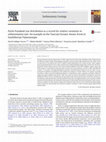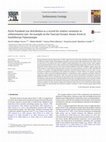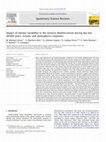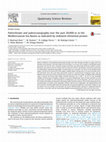Papers by Vanesa Nieto-Moreno
Quaternary Science Reviews, 2012

The Early Toarcian Oceanic Anoxic Event (T-OAE) represents one of the major alterations of the ca... more The Early Toarcian Oceanic Anoxic Event (T-OAE) represents one of the major alterations of the carbon cycle of the Mesozoic period. Despite being globally recognized, and particularly represented within the Tethys realm, its expression in the sedimentary record is highly variable depending on the studied section, which suggests local environmental factors exert a major control on the resulting lithological appearance of the event. We investigated the Fuente Vidriera section, in the eastern External Subbetic of the Betic Cordillera (Spain), where the Lower Jurassic is represented by alternate layers of marls and marly limestones, and the T-OAE is identified by a major δ 13 C excursion, micropalaeontological, ichnofacies and geochemical evidences. For this study, we analyzed pyrite framboid size distribution of the sedimentary sequence in Fuente Vidriera. The outcome, according to previous studies on pyrite framboid distribution, is contradictory when compared to all other evidences, suggesting oxygen depletion during the T-OAE. The results have been reinterpreted in the light of Crystal Size Distribution Theory and we conclude that not only growth time but also geochemical environment controls pyrite formation. Since growth time is directly related to burial rates, this approach allows us to reconstruct relative variations of sedimentation rates during the Early Jurassic in this location. Based on the obtained results, we provide new evidences for wide-spread transgression during the Early Toarcian in the South Iberian palaeomargin, which induced low sedimentation rate and lower energetic conditions, as well as favored oxygen impoverished bottom waters.

The Early Toarcian Oceanic Anoxic Event (T-OAE) represents one of the major alterations of the ca... more The Early Toarcian Oceanic Anoxic Event (T-OAE) represents one of the major alterations of the carbon cycle of the Mesozoic period. Despite being globally recognized, and particularly represented within the Tethys realm, its expression in the sedimentary record is highly variable depending on the studied section, which suggests local environmental factors exert a major control on the resulting lithological appearance of the event. We investigated the Fuente Vidriera section, in the eastern External Subbetic of the Betic Cordillera (Spain), where the Lower Jurassic is represented by alternate layers of marls and marly limestones, and the T-OAE is identified by a major δ13C excursion, micropalaeontological, ichnofacies and geochemical evidences. For this study, we analyzed pyrite framboid size distribution of the sedimentary sequence in Fuente Vidriera. The outcome, according to previous studies on pyrite framboid distribution, is contradictory when compared to all other evidences, suggesting oxygen depletion during the T-OAE. The results have been reinterpreted in the light of Crystal Size Distribution Theory and we conclude that not only growth time but also geochemical environment controls pyrite formation. Since growth time is directly related to burial rates, this approach allows us to reconstruct relative variations of sedimentation rates during the Early Jurassic in this location. Based on the obtained results, we provide new evidences for wide-spread transgression during the Early Toarcian in the South Iberian palaeomargin, which induced low sedimentation rate and lower energetic conditions, as well as favored oxygen impoverished bottom waters.

Eolian input fluctuations and paleoceanographic conditions in the western Mediterranean have been... more Eolian input fluctuations and paleoceanographic conditions in the western Mediterranean have been reconstructed by using a multi-proxy approach to infer climate variability for the last 20,000 yr. A sediment core from the East Alboran Sea basin provides high-resolution geochemical, mineralogical and grain size distribution records from the Last Glacial Maximum onward. The accurate chronology obtained, closely related with the North Greenland Ice core Project, has provided a detailed paleoclimate reconstruction at the centennialemillennial time scale. Mineral and chemical compositions as well as sediment grain size distribution have been used to establish both fluvial and eolian input variations, deep-water current intensity, and ventilation and productivity conditions at the time of deposition. During the cold period Greenland Stadial-2a, the analyzed proxies evidence significant climate oscillations. Redox proxies, showing marked Mn/Al and Fe/Al peaks, as well as granulometric parameters, support major changes in thermohaline circulation, with active circulation triggered by the Western Mediterranean Deep Water formation. Ba/Al ratios and the presence of authigenic barite point to high productivity during the Last Heinrich event. At this time, Zr/Al, Si/Al and Ti/Al ratios as well as quartz and palygorskite contents also corroborate dryer conditions in the Alboran borderlands, with a major reorganization of atmospheric circulation at the beginning of the deglaciation and during the Last Heinrich event. In contrast, a decreasing trend in the Zr/Al ratio and increasing Mg/Al, K/Al and illite þ chlorite/kaolinite ratios would indicate enhanced river runoff and supporting lower eolian dust input and wetter periods during the Bölling eAlleröd. Short-term and abrupt climate oscillations such as the Intra-Alleröd Cold Period are likewise reflected by minor yet conspicuous changes in eolian proxies. During the Younger Dryas, we distinguish an initial cold and dry phase, with major westerlies intensity, thermohaline reactivation, and high productivity levels, and a second wetter phase characterized by sporadic rainfalls over poorly vegetated surrounding continental areas. Then, during the Holocene, alternating phases of major humidity and aridity were recorded by major fluctuations in detrital input. These are also correlated with recurrent forest cover declines reported from pollen records, with a noteworthy early decline in the African Humid Period. During the Holocene, an initial demise of the Last Organic-Rich Layer is also evidenced, tentatively associated with aspiration forces promoted by intense thermohaline circulation through the Gibraltar Strait.

Journal of the Geological Society of London 172:264-271, Mar 10, 2015
Previous studies have revealed the excellence of the westernmost Mediterranean records for recons... more Previous studies have revealed the excellence of the westernmost Mediterranean records for reconstructing climate conditions over the last two millennia. In particular, inorganic and organic proxies have revealed a coherent signal of climate and oceanographic responses during this time. Here we compare and integrate both proxy records for reconstructing climate and oceanographic conditions with focus on the last millennium. The higher temperatures indicated by lipid-based proxies during the Medieval Climate Anomaly (MCA) are coincident with drier conditions indicated by inorganic proxies. In contrast, lower temperatures and humid conditions are indicated during the Little Ice Age (LIA). The industrial period was characterized by increasing humidity in comparison with the previous LIA. However, a progressive aridification occurred since the second half of the 20th century, coexisting with a warming trend and higher contribution of C3 grasses. Proxy records are also interpreted to show Atlantic water inflow at AD 1450 and 1950 and an intensification of the upwelling conditions coinciding with a prolonged positive North Atlantic Oscillation (NAO) phase in the intervals AD 1000–1450 and 1960–1990. Large-scale oceanic–atmospheric circulation patterns (the NAO and the Atlantic meridional circulation) and solar irradiance variations seem to have played the major key role during the last millennium, together with anthropogenic contributions in the more recent record.

Quaternary Science Reviews 107: 25-46, Nov 4, 2014
Marine sediments record paleoenvironmental changes over time through variations in major and trac... more Marine sediments record paleoenvironmental changes over time through variations in major and trace element concentrations. The main objective of this paper is to review such changes in the Mediterranean Sea basins over the last 20 ka, using the inorganic chemistry and mineralogy of marine sediment records. Elemental ratio proxies that are mostly used are discussed, and the uncertainties involved in using them for paleoclimate and paleoceanographic reconstructions are evaluated. The focus on the Mediterranean region is based on the sensitivity of this region to global climate changes due to its semi-enclosed nature. The elemental ratios that have been particularly useful for reconstructing terrigenous inputs into the Mediterranean have been Ti/Al and Zr/Al ratios as proxies for eolian dust input, and Mg/Al, K/Al and Rb/Al ratios as proxies for fluvial input. Redox sensitive elements (e.g., U, Mo, V, Co, Ni, Cr) have provided reliable reconstructions of oxygen conditions at the time of deposition. Some of these elements are also particularly susceptible to post-depositional remobilization and record diagenetic processes instead of the original environmental signatures. Regarding productivity fluctuations, most of the paleoproductivity reconstructions are based on the abundance of barite and Ba excess algorithms. The biogeochemistry of Ba is, however, not fully understood and mechanisms for barite precipitation in the water column are not yet known. Two case studies are presented: the eastern Mediterranean sapropel S1 (deposited between
10.8 and 6.1 cal ka BP) and the westernmost Mediterranean paleoclimate record over the last 20 ka.

The Holocene, Apr 30, 2013
An integrated multiproxy analysis from westernmost Mediterranean hemipelagic sediments has provid... more An integrated multiproxy analysis from westernmost Mediterranean hemipelagic sediments has provided further insights into natural climate variability and forcing mechanisms in this region during the last two millennia. Two deep-sea marine records, with a robust age model provided by the activity–depth profiles of 210Pb and 137Cs, together with 14C dating, allowed us to perform a detailed reconstruction of paleoenvironmental and paleoceanographic responses during the ‘Medieval Climate Anomaly’ (MCA), the ‘Little Ice Age’ (LIA), the Industrial period (IP) and the second-half of the 20th century. Decreasing trends of fluvial-derived element (Si) and a increasing eolian input (Zr/Al ratio) characterized the MCA and the second-half of the 20th century as prevalent dry periods, while generally humid conditions are evidenced during the LIA and the IP, in accordance to a positive and a negative mode of the North Atlantic Oscillation (NAO), respectively (Trouet et al., 2009). The LIA developed as a sequence of successive short and abrupt dry–humid phase alternation. Furthermore, a noteworthy and sharp decrease of redox-sensitive elements (V/Cr and Ni/Co ratios) and coarser sortable silt at ad 1450 and 1950 yr, support more energetic hydrodynamic conditions at this time (oxygenated bottom waters and faster bottom currents), likely promoted by strengthened cooler waters flowing into the Mediterranean Sea.
Organic …, 2012
and sharing with colleagues.
Climate of The Past Discussions, 2010

Climate of the Past …, 2011
Climate variability in the western Mediterranean is reconstructed for the last 4000 yr using mari... more Climate variability in the western Mediterranean is reconstructed for the last 4000 yr using marine sediments recovered in the west Algerian-Balearic Basin, near the Alboran Basin. Fluctuations in chemical and mineralogical sediment composition as well as grain size distribution are linked to fluvial-eolian oscillations, changes in redox conditions and paleocurrent intensity. Multivariate analyses allowed us to characterize three main groups of geochemical and mineralogical proxies determining the sedimentary record of this region. These three statistical groups were applied to reconstruct paleoclimate conditions at high resolution during the Late Holocene. An increase in riverine input (fluvial-derived elements -Rb/ratios), and a decrease in Saharan eolian input (Zr/Al ratio) depict the Roman Humid Period and the Little Ice Age, while drier environmental conditions are recognized during the Late Bronze Age-Iron Age, the Dark Ages and the Medieval Climate Anomaly. Additionally, faster bottom currents and more energetic hydrodynamic conditions for the former periods are evidenced by enhanced sortable silt (10-63 µm) and quartz content, and by better oxygenated bottom waters -as reflected by decreasing redox-sensitive elements (V/Al, Cr/Al, Ni/Al and Zn/Al ratios). In contrast, opposite paleoceanographic conditions are distinguished during the latter periods, i.e. the Late Bronze Age-Iron Age, the Dark Ages and the Medieval Climate Anomaly. Although no Ba excess was registered, other paleoproductivity indicators Correspondence to: V. Nieto-Moreno (vanesanieto@ugr.es) (total organic carbon content, Br/Al ratio, and organometallic ligands such as U and Cu) display the highest values during the Roman Humid Period, and together with increasing preservation of organic matter, this period exhibits by far the most intense productivity of the last 4000 yr. Fluctuations in detrital input into the basin as the main process managing deposition, reflected by the first eigenvector defined by the Principal Component Analyses, point to solar irradiance and the North Atlantic Oscillation variability as the main driving mechanisms behind natural climate variability over decadal to centennial time-scales for the last 4000 yr.
1 Resumen 5 Motivation, objectives and layout 9
Quaternary Science …, 2012

Uploads
Papers by Vanesa Nieto-Moreno
10.8 and 6.1 cal ka BP) and the westernmost Mediterranean paleoclimate record over the last 20 ka.
10.8 and 6.1 cal ka BP) and the westernmost Mediterranean paleoclimate record over the last 20 ka.